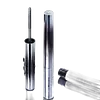What's inside
What's inside
 Key Ingredients
Key Ingredients

 Benefits
Benefits

 Concerns
Concerns

 Ingredients Side-by-side
Ingredients Side-by-side

Isododecane
EmollientTrimethylsiloxysilicate
EmollientDextrin Palmitate
EmulsifyingMicrocrystalline Wax
Emulsion StabilisingCeresin
Emulsion StabilisingPolypropylsilsesquioxane
Paraffin
PerfumingBenzalkonium Montmorillonite
EmulsifyingHydrogenated Polyisobutene
EmollientSynthetic Wax
AbrasiveRayon
CI 77491
Cosmetic ColorantCI 77499
Cosmetic ColorantCI 77007
Cosmetic ColorantPropylene Carbonate
SolventSilica
AbrasivePolymethylsilsesquioxane
Phenethyl Alcohol
MaskingCaprylic/Capric Glycerides Polyglyceryl-10 Esters
EmollientCI 77492
Cosmetic ColorantMica
Cosmetic ColorantCI 75470
Cosmetic ColorantTriethoxycaprylylsilane
CI 77266
Cosmetic ColorantPanthenol
Skin ConditioningBHT
AntioxidantIsododecane, Trimethylsiloxysilicate, Dextrin Palmitate, Microcrystalline Wax, Ceresin, Polypropylsilsesquioxane, Paraffin, Benzalkonium Montmorillonite, Hydrogenated Polyisobutene, Synthetic Wax, Rayon, CI 77491, CI 77499, CI 77007, Propylene Carbonate, Silica, Polymethylsilsesquioxane, Phenethyl Alcohol, Caprylic/Capric Glycerides Polyglyceryl-10 Esters, CI 77492, Mica, CI 75470, Triethoxycaprylylsilane, CI 77266, Panthenol, BHT
Isododecane
EmollientTrimethylsiloxysilicate
EmollientMethyl Trimethicone
Skin ConditioningSynthetic Wax
AbrasiveDextrin Palmitate
EmulsifyingMicrocrystalline Wax
Emulsion StabilisingBeeswax
Emulsion StabilisingParaffin
PerfumingIsostearic Acid
CleansingCopernicia Cerifera Wax
Petrolatum
EmollientOctyldodecyl Isostearate
Skin ConditioningPentaerythrityl Hydrogenated Rosinate
Polyethylene
AbrasiveTocopherol
AntioxidantCamellia Seed Oil
Olea Europaea Fruit Oil
MaskingSimmondsia Chinensis Seed Oil
EmollientSqualane
EmollientPanthenol
Skin ConditioningAlcohol Denat.
AntimicrobialWater
Skin ConditioningRoyal Jelly Extract
Skin ConditioningPhenoxyethanol
PreservativeSilica
AbrasiveTalc
AbrasiveMica
Cosmetic ColorantCI 77492
Cosmetic ColorantIsododecane, Trimethylsiloxysilicate, Methyl Trimethicone, Synthetic Wax, Dextrin Palmitate, Microcrystalline Wax, Beeswax, Paraffin, Isostearic Acid, Copernicia Cerifera Wax, Petrolatum, Octyldodecyl Isostearate, Pentaerythrityl Hydrogenated Rosinate, Polyethylene, Tocopherol, Camellia Seed Oil, Olea Europaea Fruit Oil, Simmondsia Chinensis Seed Oil, Squalane, Panthenol, Alcohol Denat., Water, Royal Jelly Extract, Phenoxyethanol, Silica, Talc, Mica, CI 77492
 Reviews
Reviews

Ingredients Explained
These ingredients are found in both products.
Ingredients higher up in an ingredient list are typically present in a larger amount.
Ci 77492 is also hydrated iron III oxide. It's sole purpose is to give a yellow hue to products.
Iron III oxides are classified as inorganic chemicals for coloring.
Synthetically created Ci 77492 is considered safer than those naturally found. This is because the synthetically created version may contain less impurities. Iron oxides are generally non-toxic and non-allergenic.
Learn more about CI 77492Dextrin Palmitate comes from the palmitic acid ester of Dextrin. It is used as an emulsifier and texture enhancer.
Emulsifiers help keep ingredients together. According to a manufacturer, dextrin palmitate helps create a low-viscosity gel texture.
Due to its fatty acid base, this ingredient is not fungal-acne safe.
Learn more about Dextrin PalmitateIsododecane is a fragrance, emollient, and solvent.
As an emollient, it helps your skin stay soft and hydrated. Emollients help trap moisture into your skin.
Isododecane's role as a solvent makes it a great texture enhancer. It spreads smoothly on skin and does not leave a sticky feeling behind. Isododecane also helps prevent color transfer in makeup products.
Isododecane is not absorbed into skin.
Learn more about IsododecaneMica is a naturally occurring mineral used to add shimmer and color in cosmetics. It can also help improve the texture of a product or give it an opaque, white/silver color.
Serecite is the name for very fine but ragged grains of mica.
This ingredient is often coated with metal oxides like titanium dioxide. Trace amounts of heavy metals may be found in mica, but these metals are not harmful in our personal products.
Mica has been used since prehistoric times throughout the world. Ancient Egyptian, Indian, Greek, Roman, Aztec, and Chinese civilizations have used mica.
Learn more about MicaMicrocrystalline Wax is created by de-oiling petroleum. It is highly refined and purified before being added to cosmetics.
Microcrystalline Wax is used to enhance the texture and create even consistency. It helps stabilize a product by preventing ingredients from separating.
Panthenol is a common ingredient that helps hydrate and soothe the skin. It is found naturally in our skin and hair.
There are two forms of panthenol: D and L.
D-panthenol is also known as dexpanthenol. Most cosmetics use dexpanthenol or a mixture of D and L-panthenol.
Panthenol is famous due to its ability to go deeper into the skin's layers. Using this ingredient has numerous pros (and no cons):
Like hyaluronic acid, panthenol is a humectant. Humectants are able to bind and hold large amounts of water to keep skin hydrated.
This ingredient works well for wound healing. It works by increasing tissue in the wound and helps close open wounds.
Once oxidized, panthenol converts to pantothenic acid. Panthothenic acid is found in all living cells.
This ingredient is also referred to as pro-vitamin B5.
Learn more about PanthenolParaffin is a solid created from petroleum. The term 'paraffin' can also refer to either
petroleum jelly or mineral oil.
It has natural occlusive properties which can worsen oily skin. Due to its petrolatum base, this ingredient is not fungal-acne safe.
Silica, also known as silicon dioxide, is a naturally occurring mineral. It is used as a fine, spherical, and porous powder in cosmetics.
Though it has exfoliant properties, the function of silica varies depending on the product.
The unique structure of silica enhances the spreadability and adds smoothness, making it a great texture enhancer.
It is also used as an active carrier, emulsifier, and mattifier due to its ability to absorb excess oil.
In some products, tiny microneedles called spicules are made from silica or hydrolyzed sponge. When you rub them in, they lightly polish away dead skin layers and enhance the penetration of active ingredients.
Learn more about SilicaSynthetic Wax is created from fossil fuels such as natural gas. It is used to enhance texture, adjust pH, and as an occlusive.
It may also be used as an abrasive ingredient to exfoliate the skin.
Synthetic Wax may not be fungal acne safe.
Learn more about Synthetic WaxThis silicone is an emollient. Emollients create a thin film on the skin to prevent moisture from escaping.
It is not soluble in water and helps increase water-resistance in products.
According to a manufacturer, it can blend seamlessly with silicone oils, such as Cyclopentasiloxane.
Learn more about Trimethylsiloxysilicate